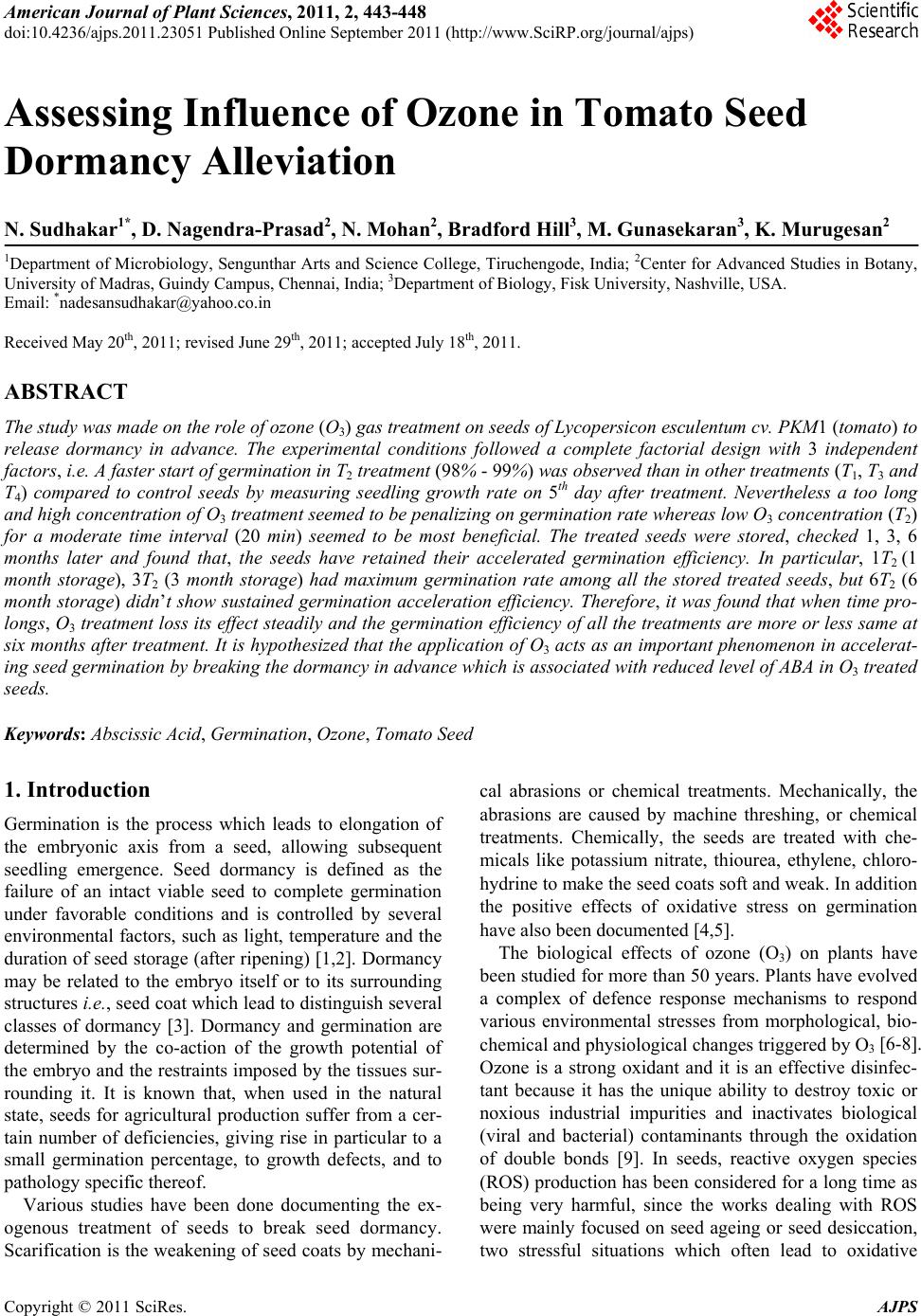 American Journal of Plant Sciences, 2011, 2, 443-448 doi:10.4236/ajps.2011.23051 Published Online September 2011 (http://www.SciRP.org/journal/ajps) Copyright © 2011 SciRes. AJPS 443 Assessing Influence of Ozone in Tomato Seed Dormancy Alleviation N. Sudhakar1*, D. Nagendra-Prasad2, N. Mohan2, Bradford Hill3, M. Gunasekaran3, K. Murugesan2 1Department of Microbiology, Sengunthar Arts and Science College, Tiruchengode, India; 2Center for Advanced Studies in Botany, University of Madras, Guindy Campus, Chennai, India; 3Department of Biology, Fisk University, Nashville, USA. Email: *nadesansudhakar@yahoo.co.in Received May 20th, 2011; revised June 29th, 2011; accepted July 18th, 2011. ABSTRACT The study was made on th e role of ozone (O3) gas treatmen t on seeds of Lycop ersicon esculent um cv. PKM 1 (tomato) to release dormancy in advance. The experimental conditions followed a complete factorial design with 3 independent factors, i.e. A faster start of germination in T2 treatment (98% - 99%) was observed than in other treatments (T1, T3 and T4) compared to control seeds by measuring seedling growth rate on 5th day after treatment. Nevertheless a too long and high concentration of O3 treatment seemed to be penalizing on germinatio n rate wherea s low O3 concen tration (T2) for a moderate time interval (20 min) seemed to be most beneficial. The treated seeds were stored, checked 1, 3, 6 months later and found that, the seeds have retained their accelerated germination efficiency. In particular, 1T2 (1 month storage), 3T2 (3 month storage) had maximum germination rate among all the stored treated seeds, but 6T2 (6 month storage) didn’t show sustained germination acceleration efficiency. Therefore, it was found that when time pro- longs, O3 treatment loss its effect steadily and the g ermination efficiency of all the treatments ar e more or less same at six months after treatment. It is hypothesized that th e application of O3 acts as an important phenomenon in accelerat- ing seed germination by breaking the dormancy in advance which is associated with reduced level of ABA in O3 treated seeds. Keywords: Abscissic Acid, Germination, Ozone , Tomato See d 1. Introduction Germination is the process which leads to elongation of the embryonic axis from a seed, allowing subsequent seedling emergence. Seed dormancy is defined as the failure of an intact viable seed to complete germination under favorable conditions and is controlled by several environmental factors, such as light, temperature and the duration of seed storage (after ripening) [1,2]. Dormancy may be related to the embryo itself or to its surrounding structures i.e., seed coat which lead to distinguish several classes of dormancy [3]. Dormancy and germination are determined by the co-action of the growth potential of the embryo and the restraints imposed by the tissues sur- rounding it. It is known that, when used in the natural state, seeds for agricultural production suffer from a cer- tain number of deficiencies, giving rise in particular to a small germination percentage, to growth defects, and to pathology specific thereof. Various studies have been done documenting the ex- ogenous treatment of seeds to break seed dormancy. Scarification is the weakening of seed coats by mechani- cal abrasions or chemical treatments. Mechanically, the abrasions are caused by machine threshing, or chemical treatments. Chemically, the seeds are treated with che- micals like potassium nitrate, thiourea, ethylene, chloro- hydrine to make the seed coats soft and weak. In addition the positive effects of oxidative stress on germination have also been documented [4,5]. The biological effects of ozone (O3) on plants have been studied for more than 50 years. Plants have evolved a complex of defence response mechanisms to respond various environmental stresses from morphological, bio- chemical and physiological changes triggered by O3 [6-8]. Ozone is a strong oxidant and it is an effective disinfec- tant because it has the unique ability to destroy toxic or noxious industrial impurities and inactivates biological (viral and bacterial) contaminants through the oxidation of double bonds [9]. In seeds, reactive oxygen species (ROS) production has been considered for a long time as being very harmful, since the works dealing with ROS were mainly focused on seed ageing or seed desiccation, two stressful situations which often lead to oxidative 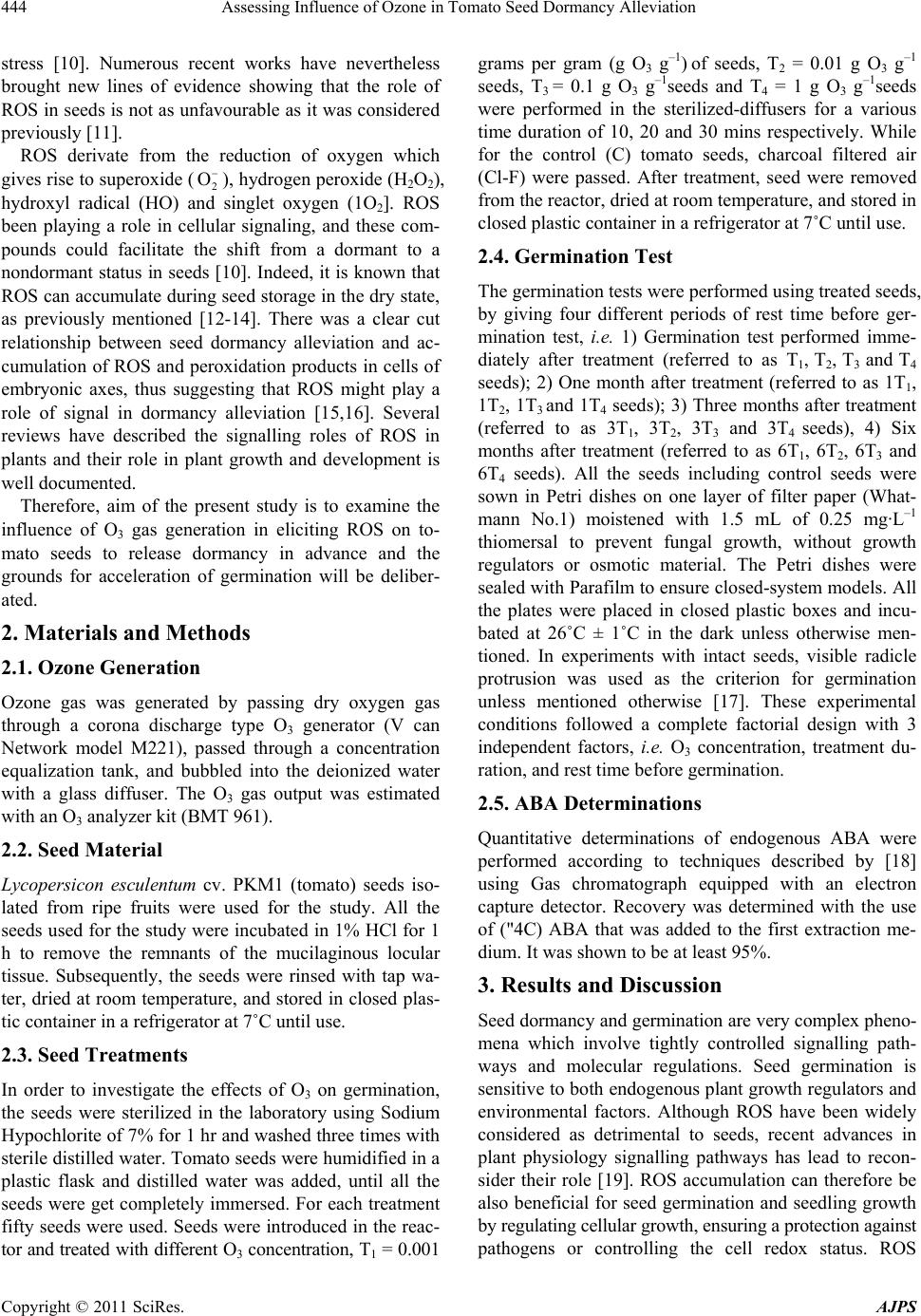 Assessing Influence of Ozone in Tomato Seed Dormancy Alleviation 444 stress [10]. Numerous recent works have nevertheless brought new lines of evidence showing that the role of ROS in seeds is not as unfavourable as it was considered previously [11]. ROS derivate from the reduction of oxygen which gives rise to superoxide (2 O), hydrogen peroxide (H2O2), hydroxyl radical (HO) and singlet oxygen (1O2]. ROS been playing a role in cellular signaling, and these com- pounds could facilitate the shift from a dormant to a nondormant status in seeds [10]. Indeed, it is known that ROS can accumulate during seed storage in the dry state, as previously mentioned [12-14]. There was a clear cut relationship between seed dormancy alleviation and ac- cumulation of ROS and peroxidation products in cells of embryonic axes, thus suggesting that ROS might play a role of signal in dormancy alleviation [15,16]. Several reviews have described the signalling roles of ROS in plants and their role in plant growth and development is well documented. Therefore, aim of the present study is to examine the influence of O3 gas generation in eliciting ROS on to- mato seeds to release dormancy in advance and the grounds for acceleration of germination will be deliber- ated. 2. Materials and Methods 2.1. Ozone Generation Ozone gas was generated by passing dry oxygen gas through a corona discharge type O3 generator (V can Network model M221), passed through a concentration equalization tank, and bubbled into the deionized water with a glass diffuser. The O3 gas output was estimated with an O3 analyzer kit (BMT 961). 2.2. Seed Material Lycopersicon esculentum cv. PKM1 (tomato) seeds iso- lated from ripe fruits were used for the study. All the seeds used for the study were incubated in 1% HCl for 1 h to remove the remnants of the mucilaginous locular tissue. Subsequently, the seeds were rinsed with tap wa- ter, dried at room temperature, and stored in closed plas- tic container in a refrigerator at 7˚C until use. 2.3. Seed Treatments In order to investigate the effects of O3 on germination, the seeds were sterilized in the laboratory using Sodium Hypochlorite of 7% for 1 hr and washed three times with sterile distilled water. Tomato seeds were humidified in a plastic flask and distilled water was added, until all the seeds were get completely immersed. For each treatment fifty seeds were used. Seeds were introduced in the reac- tor and treated with different O3 concentration, T1 = 0.001 grams per gram (g O3 g –1) of seeds, T2 = 0.01 g O3 g –1 seeds, T3 = 0.1 g O3 g –1seeds and T4 = 1 g O3 g –1seeds were performed in the sterilized-diffusers for a various time duration of 10, 20 and 30 mins respectively. While for the control (C) tomato seeds, charcoal filtered air (Cl-F) were passed. After treatment, seed were removed from the reactor, dried at room temperature, and stored in closed plastic container in a refrigerator at 7˚C until use. 2.4. Germination Test The germination tests were performed using treated seeds, by giving four different periods of rest time before ger- mination test, i.e. 1) Germination test performed imme- diately after treatment (referred to as T1, T2, T3 and T4 seeds); 2) One month after treatment (referred to as 1T1, 1T2, 1T3 and 1T4 seeds); 3) Three months after treatment (referred to as 3T1, 3T2, 3T3 and 3T4 seeds), 4) Six months after treatment (referred to as 6T1, 6T2, 6T3 and 6T4 seeds). All the seeds including control seeds were sown in Petri dishes on one layer of filter paper (What- mann No.1) moistened with 1.5 mL of 0.25 mg·L–1 thiomersal to prevent fungal growth, without growth regulators or osmotic material. The Petri dishes were sealed with Parafilm to ensure closed-system models. All the plates were placed in closed plastic boxes and incu- bated at 26˚C ± 1˚C in the dark unless otherwise men- tioned. In experiments with intact seeds, visible radicle protrusion was used as the criterion for germination unless mentioned otherwise [17]. These experimental conditions followed a complete factorial design with 3 independent factors, i.e. O3 concentration, treatment du- ration, and rest time before germination. 2.5. ABA Determinations Quantitative determinations of endogenous ABA were performed according to techniques described by [18] using Gas chromatograph equipped with an electron capture detector. Recovery was determined with the use of ("4C) ABA that was added to the first extraction me- dium. It was shown to be at least 95%. 3. Results and Discussion Seed dormancy and germination are very complex pheno- mena which involve tightly controlled signalling path- ways and molecular regulations. Seed germination is sensitive to both endogenous plant growth regulators and environmental factors. Although ROS have been widely considered as detrimental to seeds, recent advances in plant physiology signalling pathways has lead to recon- sider their role [19]. ROS accumulation can therefore be also beneficial for seed germination and seedling growth by regulating cellular growth, ensuring a protection against pathogens or controlling the cell redox status. ROS Copyright © 2011 SciRes. AJPS 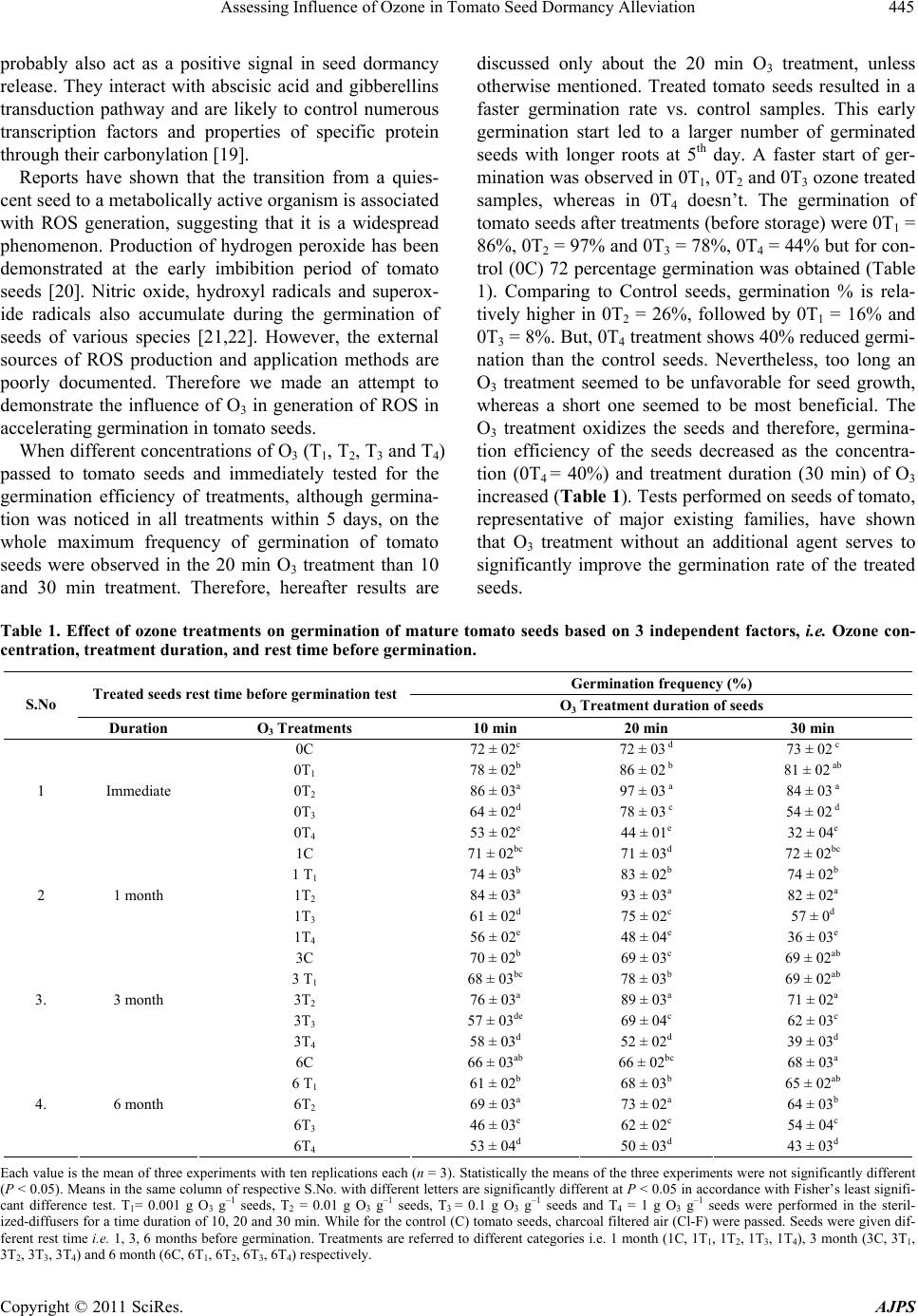 Assessing Influence of Ozone in Tomato Seed Dormancy Alleviation Copyright © 2011 SciRes. AJPS 445 probably also act as a positive signal in seed dormancy release. They interact with abscisic acid and gibberellins transduction pathway and are likely to control numerous transcription factors and properties of specific protein through their carbonylation [19]. Reports have shown that the transition from a quies- cent seed to a metabolically active organism is associated with ROS generation, suggesting that it is a widespread phenomenon. Production of hydrogen peroxide has been demonstrated at the early imbibition period of tomato seeds [20]. Nitric oxide, hydroxyl radicals and superox- ide radicals also accumulate during the germination of seeds of various species [21,22]. However, the external sources of ROS production and application methods are poorly documented. Therefore we made an attempt to demonstrate the influence of O3 in generation of ROS in accelerating germination in tomato seeds. When different concentrations of O3 (T1, T2, T3 and T4) passed to tomato seeds and immediately tested for the germination efficiency of treatments, although germina- tion was noticed in all treatments within 5 days, on the whole maximum frequency of germination of tomato seeds were observed in the 20 min O3 treatment than 10 and 30 min treatment. Therefore, hereafter results are discussed only about the 20 min O3 treatment, unless otherwise mentioned. Treated tomato seeds resulted in a faster germination rate vs. control samples. This early germination start led to a larger number of germinated seeds with longer roots at 5th day. A faster start of ger- mination was observed in 0T1, 0T2 and 0T3 ozone treated samples, whereas in 0T4 doesn’t. The germination of tomato seeds after treatments (before storage) were 0T1 = 86%, 0T2 = 97% and 0T3 = 78%, 0T4 = 44% but for con- trol (0C) 72 percentage germination was obtained (Table 1). Comparing to Control seeds, germination % is rela- tively higher in 0T2 = 26%, followed by 0T1 = 16% and 0T3 = 8%. But, 0T4 treatment shows 40% reduced germi- nation than the control seeds. Nevertheless, too long an O3 treatment seemed to be unfavorable for seed growth, whereas a short one seemed to be most beneficial. The O3 treatment oxidizes the seeds and therefore, germina- tion efficiency of the seeds decreased as the concentra- tion (0T4 = 40%) and treatment duration (30 min) of O3 increased (Table 1). Tests performed on seeds of tomato, representative of major existing families, have shown that O3 treatment without an additional agent serves to significantly improve the germination rate of the treated seeds. Table 1. Effect of ozone treatments on germination of mature tomato seeds based on 3 independent factors, i.e. Ozone con- centration, treatment duration, and rest time befor e ger mination. Germination frequency (%) Treated seeds rest time before germination testO3 Treatment duration of seeds S.No Duration O3 Treatments 10 min 20 min 30 min 0C 72 ± 02c 72 ± 03 d 73 ± 02 c 0T1 78 ± 02b 86 ± 02 b 81 ± 02 ab 0T2 86 ± 03a 97 ± 03 a 84 ± 03 a 0T3 64 ± 02d 78 ± 03 c 54 ± 02 d 1 Immediate 0T4 53 ± 02e 44 ± 01e 32 ± 04e 1C 71 ± 02bc 71 ± 03d 72 ± 02bc 1 T1 74 ± 03b 83 ± 02b 74 ± 02b 1T2 84 ± 03a 93 ± 03a 82 ± 02a 1T3 61 ± 02d 75 ± 02c 57 ± 0d 2 1 month 1T4 56 ± 02e 48 ± 04e 36 ± 03e 3C 70 ± 02b 69 ± 03c 69 ± 02ab 3 T1 68 ± 03bc 78 ± 03b 69 ± 02ab 3T2 76 ± 03a 89 ± 03a 71 ± 02a 3T3 57 ± 03de 69 ± 04c 62 ± 03c 3. 3 month 3T4 58 ± 03d 52 ± 02d 39 ± 03d 6C 66 ± 03ab 66 ± 02bc 68 ± 03a 6 T1 61 ± 02b 68 ± 03b 65 ± 02ab 6T2 69 ± 03a 73 ± 02a 64 ± 03b 6T3 46 ± 03e 62 ± 02c 54 ± 04c 4. 6 month 6T4 53 ± 04d 50 ± 03d 43 ± 03d Each value is the mean of three experiments with ten replications each (n = 3). Statistically the means of the three experiments were not significantly different (P < 0.05). Means in the same column of respective S.No. with different letters are significantly different at P < 0.05 in accordance with Fisher’s least signifi- cant difference test. T1= 0.001 g O3 g –1 seeds, T2 = 0.01 g O3 g –1 seeds, T3 = 0.1 g O3 g –1 seeds and T4 = 1 g O3 g –1 seeds were performed in the steril- ized-diffusers for a time duration of 10, 20 and 30 min. While for the control (C) tomato seeds, charcoal filtered air (Cl-F) were passed. Seeds were given dif- ferent rest time i.e. 1, 3, 6 months before germination. Treatments are referred to different categories i.e. 1 month (1C, 1T1, 1T2, 1T3, 1T4), 3 month (3C, 3T1, 3T2, 3T3, 3T4) and 6 month (6C, 6T1, 6T2, 6T3, 6T4) respectively. 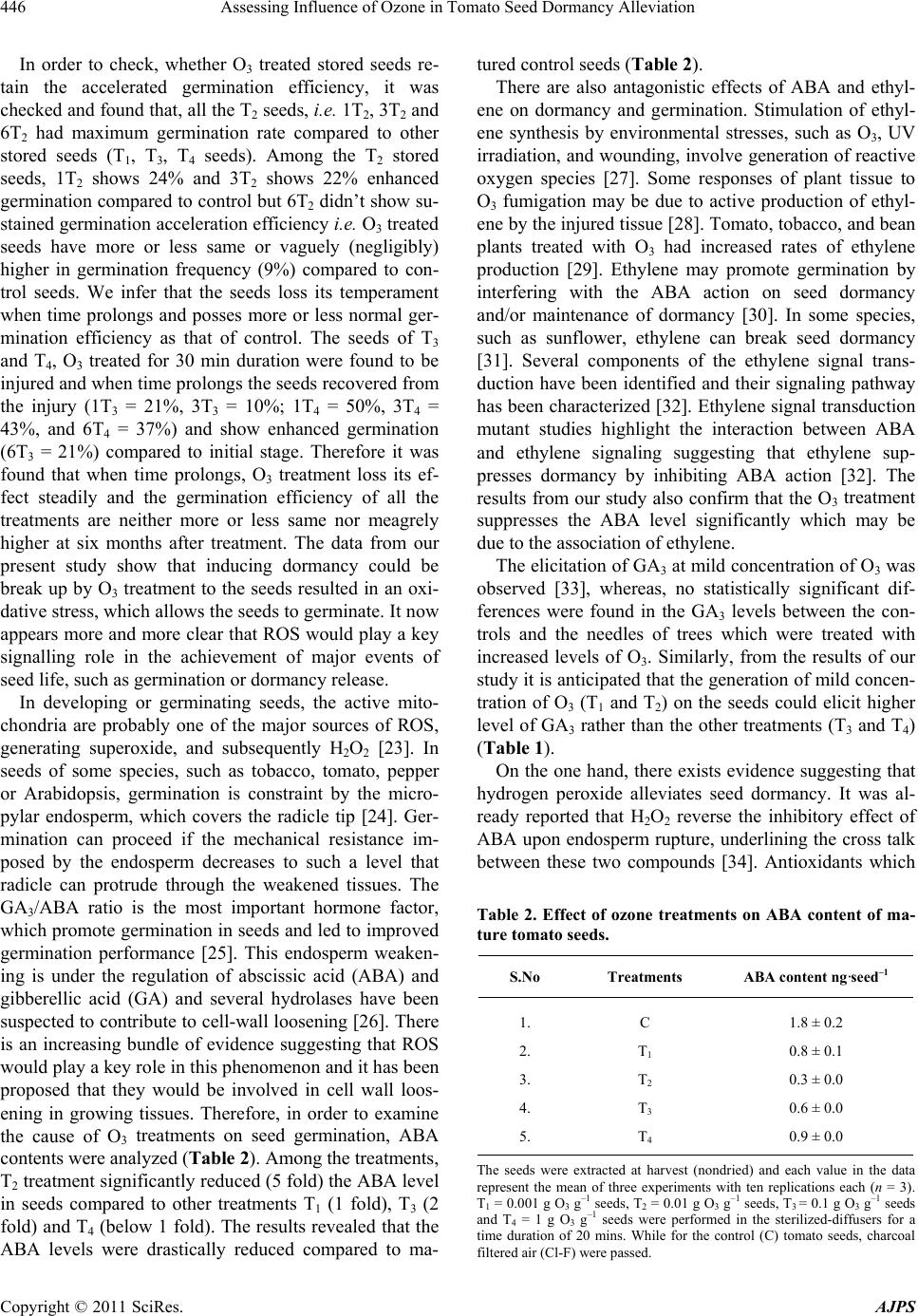 Assessing Influence of Ozone in Tomato Seed Dormancy Alleviation 446 In order to check, whether O3 treated stored seeds re- tain the accelerated germination efficiency, it was checked and found that, all the T2 seeds, i.e. 1T2, 3T2 and 6T2 had maximum germination rate compared to other stored seeds (T1, T3, T4 seeds). Among the T2 stored seeds, 1T2 shows 24% and 3T2 shows 22% enhanced germination compared to control but 6T2 didn’t show su- stained germination acceleration efficiency i.e. O3 treated seeds have more or less same or vaguely (negligibly) higher in germination frequency (9%) compared to con- trol seeds. We infer that the seeds loss its temperament when time prolongs and posses more or less normal ger- mination efficiency as that of control. The seeds of T3 and T4, O3 treated for 30 min duration were found to be injured and when time prolongs the seeds recovered from the injury (1T3 = 21%, 3T3 = 10%; 1T4 = 50%, 3T4 = 43%, and 6T4 = 37%) and show enhanced germination (6T3 = 21%) compared to initial stage. Therefore it was found that when time prolongs, O3 treatment loss its ef- fect steadily and the germination efficiency of all the treatments are neither more or less same nor meagrely higher at six months after treatment. The data from our present study show that inducing dormancy could be break up by O3 treatment to the seeds resulted in an oxi- dative stress, which allows the seeds to germinate. It now appears more and more clear that ROS would play a key signalling role in the achievement of major events of seed life, such as germination or dormancy release. In developing or germinating seeds, the active mito- chondria are probably one of the major sources of ROS, generating superoxide, and subsequently H2O2 [23]. In seeds of some species, such as tobacco, tomato, pepper or Arabidopsis, germination is constraint by the micro- pylar endosperm, which covers the radicle tip [24]. Ger- mination can proceed if the mechanical resistance im- posed by the endosperm decreases to such a level that radicle can protrude through the weakened tissues. The GA3/ABA ratio is the most important hormone factor, which promote germination in seeds and led to improved germination performance [25]. This endosperm weaken- ing is under the regulation of abscissic acid (ABA) and gibberellic acid (GA) and several hydrolases have been suspected to contribute to cell-wall loosening [26]. There is an increasing bundle of evidence suggesting that ROS would play a key role in this phenomenon and it has been proposed that they would be involved in cell wall loos- ening in growing tissues. Therefore, in order to examine the cause of O3 treatments on seed germination, ABA contents were analyzed (Table 2). Among the treatments, T2 treatment significantly reduced (5 fold) the ABA level in seeds compared to other treatments T1 (1 fold), T3 (2 fold) and T4 (below 1 fold). The results revealed that the ABA levels were drastically reduced compared to ma- tured control seeds (Table 2). There are also antagonistic effects of ABA and ethyl- ene on dormancy and germination. Stimulation of ethyl- ene synthesis by environmental stresses, such as O3, UV irradiation, and wounding, involve generation of reactive oxygen species [27]. Some responses of plant tissue to O3 fumigation may be due to active production of ethyl- ene by the injured tissue [28]. Tomato, tobacco, and bean plants treated with O3 had increased rates of ethylene production [29]. Ethylene may promote germination by interfering with the ABA action on seed dormancy and/or maintenance of dormancy [30]. In some species, such as sunflower, ethylene can break seed dormancy [31]. Several components of the ethylene signal trans- duction have been identified and their signaling pathway has been characterized [32]. Ethylene signal transduction mutant studies highlight the interaction between ABA and ethylene signaling suggesting that ethylene sup- presses dormancy by inhibiting ABA action [32]. The results from our study also confirm that the O3 treatment suppresses the ABA level significantly which may be due to the association of ethylene. The elicitation of GA3 at mild concentration of O3 was observed [33], whereas, no statistically significant dif- ferences were found in the GA3 levels between the con- trols and the needles of trees which were treated with increased levels of O3. Similarly, from the results of our study it is anticipated that the generation of mild concen- tration of O3 (T1 and T2) on the seeds could elicit higher level of GA3 rather than the other treatments (T3 and T4) (Table 1). On the one hand, there exists evidence suggesting that hydrogen peroxide alleviates seed dormancy. It was al- ready reported that H2O2 reverse the inhibitory effect of ABA upon endosperm rupture, underlining the cross talk between these two compounds [34]. Antioxidants which Table 2. Effect of ozone treatments on ABA content of ma- ture tomato seeds. S.No Treatments ABA content ng·seed–1 1. 2. 3. 4. 5. C T1 T2 T3 T4 1.8 ± 0.2 0.8 ± 0.1 0.3 ± 0.0 0.6 ± 0.0 0.9 ± 0.0 The seeds were extracted at harvest (nondried) and each value in the data represent the mean of three experiments with ten replications each (n = 3). T1 = 0.001 g O3 g–1 seeds, T2 = 0.01 g O3 g–1 seeds, T3 = 0.1 g O3 g–1 seeds and T4 = 1 g O3 g –1 seeds were performed in the sterilized-diffusers for a time duration of 20 mins. While for the control (C) tomato seeds, charcoal filtered air (Cl-F) were passed. Copyright © 2011 SciRes. AJPS 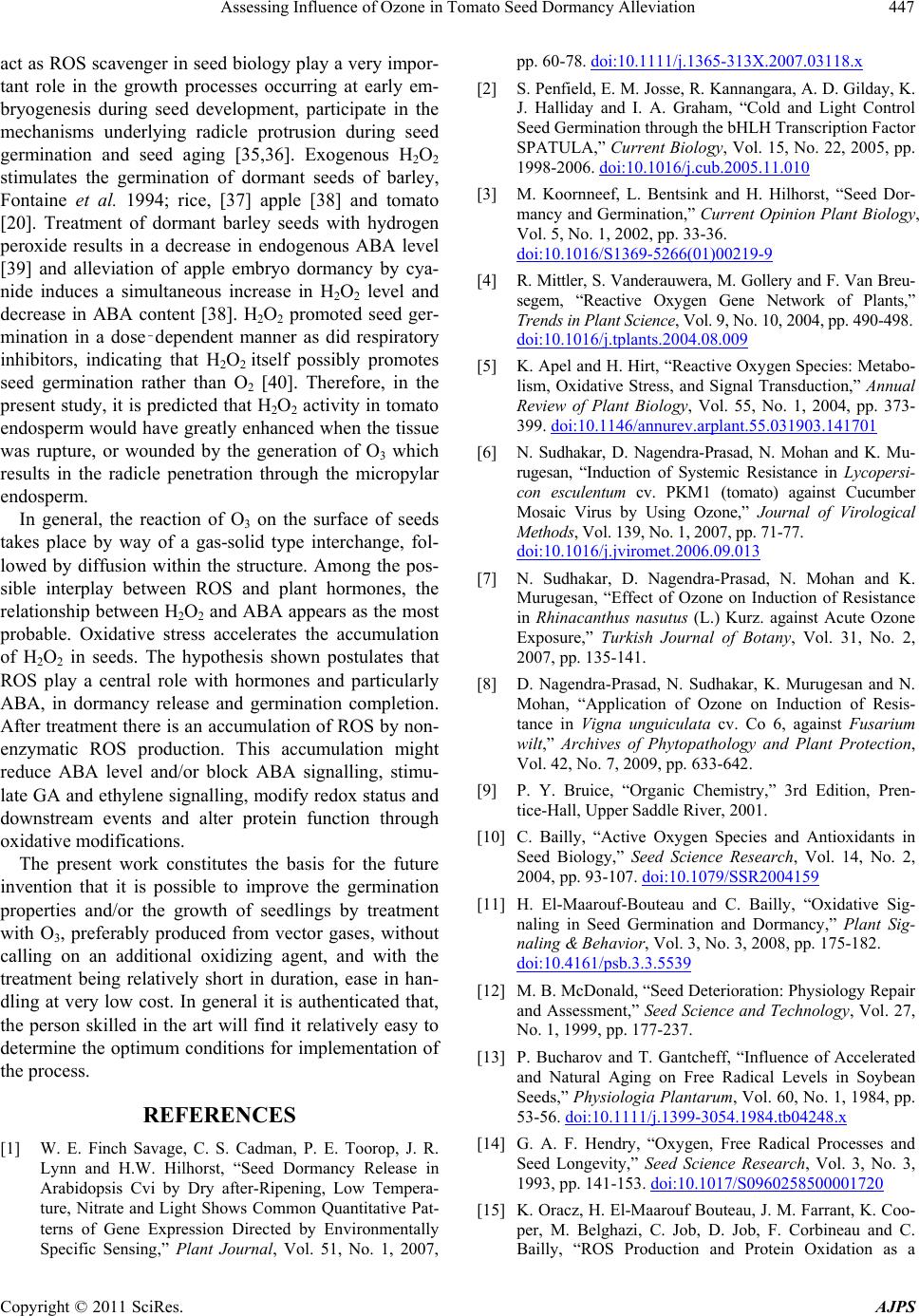 Assessing Influence of Ozone in Tomato Seed Dormancy Alleviation447 act as ROS scavenger in seed biology play a very impor- tant role in the growth processes occurring at early em- bryogenesis during seed development, participate in the mechanisms underlying radicle protrusion during seed germination and seed aging [35,36]. Exogenous H2O2 stimulates the germination of dormant seeds of barley, Fontaine et al. 1994; rice, [37] apple [38] and tomato [20]. Treatment of dormant barley seeds with hydrogen peroxide results in a decrease in endogenous ABA level [39] and alleviation of apple embryo dormancy by cya- nide induces a simultaneous increase in H2O2 level and decrease in ABA content [38]. H2O2 promoted seed ger- mination in a dose‑dependent manner as did respiratory inhibitors, indicating that H2O2 itself possibly promotes seed germination rather than O2 [40]. Therefore, in the present study, it is predicted that H2O2 activity in tomato endosperm would have greatly enhanced when the tissue was rupture, or wounded by the generation of O3 which results in the radicle penetration through the micropylar endosperm. In general, the reaction of O3 on the surface of seeds takes place by way of a gas-solid type interchange, fol- lowed by diffusion within the structure. Among the pos- sible interplay between ROS and plant hormones, the relationship between H2O2 and ABA appears as the most probable. Oxidative stress accelerates the accumulation of H2O2 in seeds. The hypothesis shown postulates that ROS play a central role with hormones and particularly ABA, in dormancy release and germination completion. After treatment there is an accumulation of ROS by non- enzymatic ROS production. This accumulation might reduce ABA level and/or block ABA signalling, stimu- late GA and ethylene signalling, modify redox status and downstream events and alter protein function through oxidative modifications. The present work constitutes the basis for the future invention that it is possible to improve the germination properties and/or the growth of seedlings by treatment with O3, preferably produced from vector gases, without calling on an additional oxidizing agent, and with the treatment being relatively short in duration, ease in han- dling at very low cost. In general it is authenticated that, the person skilled in the art will find it relatively easy to determine the optimum conditions for implementation of the process. REFERENCES [1] W. E. Finch Savage, C. S. Cadman, P. E. Toorop, J. R. Lynn and H.W. Hilhorst, “Seed Dormancy Release in Arabidopsis Cvi by Dry after-Ripening, Low Tempera- ture, Nitrate and Light Shows Common Quantitative Pat- terns of Gene Expression Directed by Environmentally Specific Sensing,” Plant Journal, Vol. 51, No. 1, 2007, pp. 60-78. doi:10.1111/j.1365-313X.2007.03118.x [2] S. Penfield, E. M. Josse, R. Kannangara, A. D. Gilday, K. J. Halliday and I. A. Graham, “Cold and Light Control Seed Germination through the bHLH Transcription Factor SPATULA,” Current Biology, Vol. 15, No. 22, 2005, pp. 1998-2006. doi:10.1016/j.cub.2005.11.010 [3] M. Koornneef, L. Bentsink and H. Hilhorst, “Seed Dor- mancy and Germination,” Current Opinion Plant Biology, Vol. 5, No. 1, 2002, pp. 33-36. doi:10.1016/S1369-5266(01)00219-9 [4] R. Mittler, S. Vanderauwera, M. Gollery and F. Van Breu- segem, “Reactive Oxygen Gene Network of Plants,” Trends in Plant Science, Vol. 9, No. 10, 2004, pp. 490-498. doi:10.1016/j.tplants.2004.08.009 [5] K. Apel and H. Hirt, “Reactive Oxygen Species: Metabo- lism, Oxidative Stress, and Signal Transduction,” Annual Review of Plant Biology, Vol. 55, No. 1, 2004, pp. 373- 399. doi:10.1146/annurev.arplant.55.031903.141701 [6] N. Sudhakar, D. Nagendra-Prasad, N. Mohan and K. Mu- rugesan, “Induction of Systemic Resistance in Lycopersi- con esculentum cv. PKM1 (tomato) against Cucumber Mosaic Virus by Using Ozone,” Journal of Virological Methods, Vol. 139, No. 1, 2007, pp. 71-77. doi:10.1016/j.jviromet.2006.09.013 [7] N. Sudhakar, D. Nagendra-Prasad, N. Mohan and K. Murugesan, “Effect of Ozone on Induction of Resistance in Rhinacanthus nasutus (L.) Kurz. against Acute Ozone Exposure,” Turkish Journal of Botany, Vol. 31, No. 2, 2007, pp. 135-141. [8] D. Nagendra-Prasad, N. Sudhakar, K. Murugesan and N. Mohan, “Application of Ozone on Induction of Resis- tance in Vigna unguiculata cv. Co 6, against Fusarium wilt,” Archives of Phytopathology and Plant Protection, Vol. 42, No. 7, 2009, pp. 633-642. [9] P. Y. Bruice, “Organic Chemistry,” 3rd Edition, Pren- tice-Hall, Upper Saddle River, 2001. [10] C. Bailly, “Active Oxygen Species and Antioxidants in Seed Biology,” Seed Science Research, Vol. 14, No. 2, 2004, pp. 93-107. doi:10.1079/SSR2004159 [11] H. El-Maarouf-Bouteau and C. Bailly, “Oxidative Sig- naling in Seed Germination and Dormancy,” Plant Sig- naling & Behavior, Vol. 3, No. 3, 2008, pp. 175-182. doi:10.4161/psb.3.3.5539 [12] M. B. McDonald, “Seed Deterioration: Physiology Repair and Assessment,” Seed Science and Technology, Vol. 27, No. 1, 1999, pp. 177-237. [13] P. Bucharov and T. Gantcheff, “Influence of Accelerated and Natural Aging on Free Radical Levels in Soybean Seeds,” Physiologia Plantarum, Vol. 60, No. 1, 1984, pp. 53-56. doi:10.1111/j.1399-3054.1984.tb04248.x [14] G. A. F. Hendry, “Oxygen, Free Radical Processes and Seed Longevity,” Seed Science Research, Vol. 3, No. 3, 1993, pp. 141-153. doi:10.1017/S0960258500001720 [15] K. Oracz, H. El-Maarouf Bouteau, J. M. Farrant, K. Coo- per, M. Belghazi, C. Job, D. Job, F. Corbineau and C. Bailly, “ROS Production and Protein Oxidation as a Copyright © 2011 SciRes. AJPS 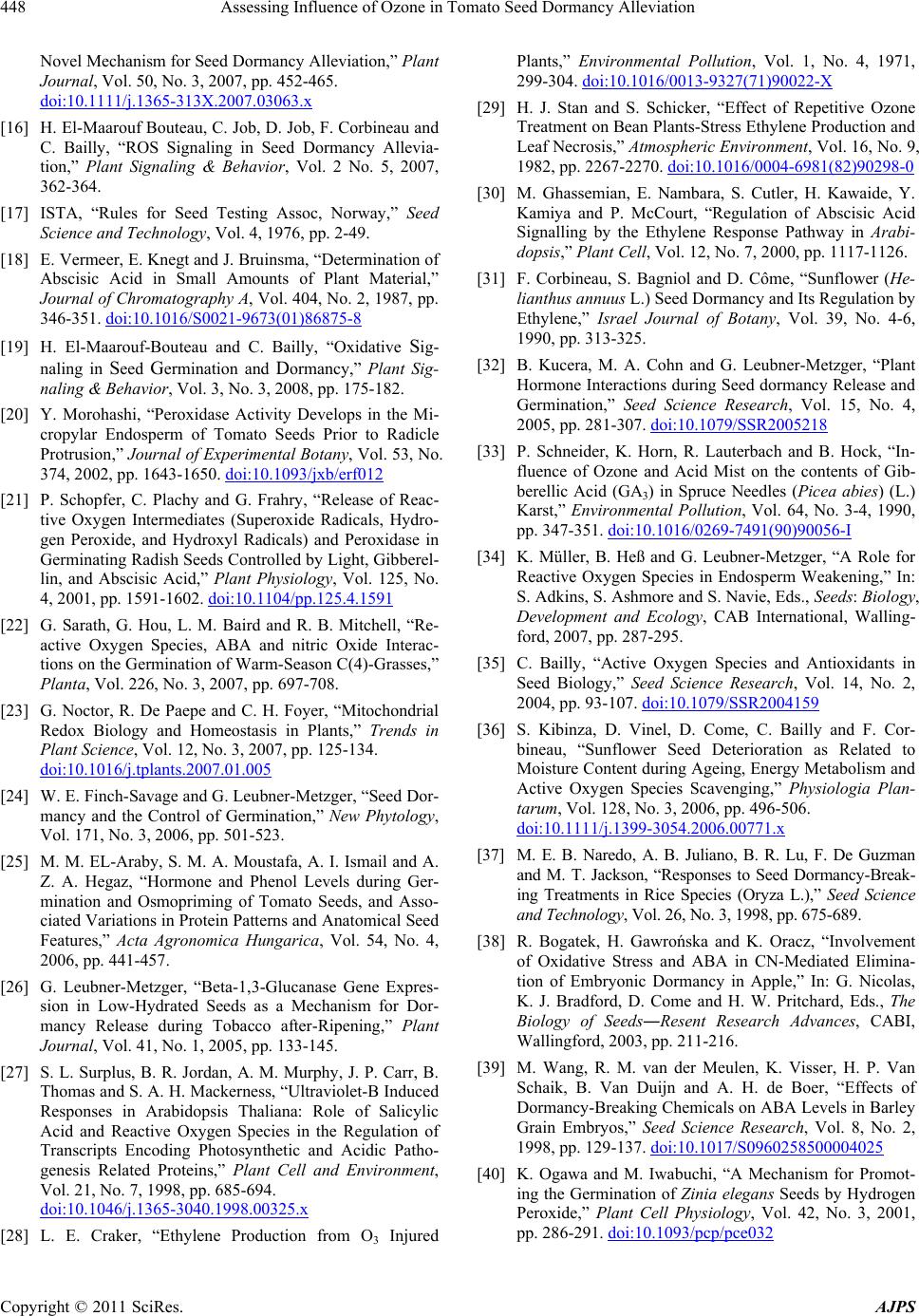 Assessing Influence of Ozone in Tomato Seed Dormancy Alleviation Copyright © 2011 SciRes. AJPS 448 Novel Mechanism for Seed Dormancy Alleviation,” Plant Journal, Vol. 50, No. 3, 2007, pp. 452-465. doi:10.1111/j.1365-313X.2007.03063.x [16] H. El-Maarouf Bouteau, C. Job, D. Job, F. Corbineau and C. Bailly, “ROS Signaling in Seed Dormancy Allevia- tion,” Plant Signaling & Behavior, Vol. 2 No. 5, 2007, 362-364. [17] ISTA, “Rules for Seed Testing Assoc, Norway,” Seed Science and Technology, Vol. 4, 1976, pp. 2-49. [18] E. Vermeer, E. Knegt and J. Bruinsma, “Determination of Abscisic Acid in Small Amounts of Plant Material,” Journal of Chromatography A, Vol. 404, No. 2, 1987, pp. 346-351. doi:10.1016/S0021-9673(01)86875-8 [19] H. El-Maarouf-Bouteau and C. Bailly, “Oxidative Sig- naling in Seed Germination and Dormancy,” Plant Sig- naling & Behavior, Vol. 3, No. 3, 2008, pp. 175-182. [20] Y. Morohashi, “Peroxidase Activity Develops in the Mi- cropylar Endosperm of Tomato Seeds Prior to Radicle Protrusion,” Journal of Experimental Botany, Vol. 53, No. 374, 2002, pp. 1643-1650. doi:10.1093/jxb/erf012 [21] P. Schopfer, C. Plachy and G. Frahry, “Release of Reac- tive Oxygen Intermediates (Superoxide Radicals, Hydro- gen Peroxide, and Hydroxyl Radicals) and Peroxidase in Germinating Radish Seeds Controlled by Light, Gibberel- lin, and Abscisic Acid,” Plant Physiology, Vol. 125, No. 4, 2001, pp. 1591-1602. doi:10.1104/pp.125.4.1591 [22] G. Sarath, G. Hou, L. M. Baird and R. B. Mitchell, “Re- active Oxygen Species, ABA and nitric Oxide Interac- tions on the Germination of Warm-Season C(4)-Grasses,” Planta, Vol. 226, No. 3, 2007, pp. 697-708. [23] G. Noctor, R. De Paepe and C. H. Foyer, “Mitochondrial Redox Biology and Homeostasis in Plants,” Trends in Plant Science, Vol. 12, No. 3, 2007, pp. 125-134. doi:10.1016/j.tplants.2007.01.005 [24] W. E. Finch-Savage and G. Leubner-Metzger, “Seed Dor- mancy and the Control of Germination,” New Phytology, Vol. 171, No. 3, 2006, pp. 501-523. [25] M. M. EL-Araby, S. M. A. Moustafa, A. I. Ismail and A. Z. A. Hegaz, “Hormone and Phenol Levels during Ger- mination and Osmopriming of Tomato Seeds, and Asso- ciated Variations in Protein Patterns and Anatomical Seed Features,” Acta Agronomica Hungarica, Vol. 54, No. 4, 2006, pp. 441-457. [26] G. Leubner-Metzger, “Beta-1,3-Glucanase Gene Expres- sion in Low-Hydrated Seeds as a Mechanism for Dor- mancy Release during Tobacco after-Ripening,” Plant Journal, Vol. 41, No. 1, 2005, pp. 133-145. [27] S. L. Surplus, B. R. Jordan, A. M. Murphy, J. P. Carr, B. Thomas and S. A. H. Mackerness, “Ultraviolet-B Induced Responses in Arabidopsis Thaliana: Role of Salicylic Acid and Reactive Oxygen Species in the Regulation of Transcripts Encoding Photosynthetic and Acidic Patho- genesis Related Proteins,” Plant Cell and Environment, Vol. 21, No. 7, 1998, pp. 685-694. doi:10.1046/j.1365-3040.1998.00325.x [28] L. E. Craker, “Ethylene Production from O3 Injured Plants,” Environmental Pollution, Vol. 1, No. 4, 1971, 299-304. doi:10.1016/0013-9327(71)90022-X [29] H. J. Stan and S. Schicker, “Effect of Repetitive Ozone Treatment on Bean Plants-Stress Ethylene Production and Leaf Necrosis,” Atmospheric Environment, Vol. 16, No. 9, 1982, pp. 2267-2270. doi:10.1016/0004-6981(82)90298-0 [30] M. Ghassemian, E. Nambara, S. Cutler, H. Kawaide, Y. Kamiya and P. McCourt, “Regulation of Abscisic Acid Signalling by the Ethylene Response Pathway in Arabi- dopsis,” Plant Cell, Vol. 12, No. 7, 2000, pp. 1117-1126. [31] F. Corbineau, S. Bagniol and D. Côme, “Sunflower (He- lianthus annuus L.) Seed Dormancy and Its Regulation by Ethylene,” Israel Journal of Botany, Vol. 39, No. 4-6, 1990, pp. 313-325. [32] B. Kucera, M. A. Cohn and G. Leubner-Metzger, “Plant Hormone Interactions during Seed dormancy Release and Germination,” Seed Science Research, Vol. 15, No. 4, 2005, pp. 281-307. doi:10.1079/SSR2005218 [33] P. Schneider, K. Horn, R. Lauterbach and B. Hock, “In- fluence of Ozone and Acid Mist on the contents of Gib- berellic Acid (GA3) in Spruce Needles (Picea abies) (L.) Karst,” Environmental Pollution, Vol. 64, No. 3-4, 1990, pp. 347-351. doi:10.1016/0269-7491(90)90056-I [34] K. Müller, B. Heß and G. Leubner-Metzger, “A Role for Reactive Oxygen Species in Endosperm Weakening,” In: S. Adkins, S. Ashmore and S. Navie, Eds., Seeds: Biology, Development and Ecology, CAB International, Walling- ford, 2007, pp. 287-295. [35] C. Bailly, “Active Oxygen Species and Antioxidants in Seed Biology,” Seed Science Research, Vol. 14, No. 2, 2004, pp. 93-107. doi:10.1079/SSR2004159 [36] S. Kibinza, D. Vinel, D. Come, C. Bailly and F. Cor- bineau, “Sunflower Seed Deterioration as Related to Moisture Content during Ageing, Energy Metabolism and Active Oxygen Species Scavenging,” Physiologia Plan- tarum, Vol. 128, No. 3, 2006, pp. 496-506. doi:10.1111/j.1399-3054.2006.00771.x [37] M. E. B. Naredo, A. B. Juliano, B. R. Lu, F. De Guzman and M. T. Jackson, “Responses to Seed Dormancy-Break- ing Treatments in Rice Species (Oryza L.),” Seed Science and Technology, Vol. 26, No. 3, 1998, pp. 675-689. [38] R. Bogatek, H. Gawrońska and K. Oracz, “Involvement of Oxidative Stress and ABA in CN-Mediated Elimina- tion of Embryonic Dormancy in Apple,” In: G. Nicolas, K. J. Bradford, D. Come and H. W. Pritchard, Eds., The Biology of Seeds―Resent Research Advances, CABI, Wallingford, 2003, pp. 211-216. [39] M. Wang, R. M. van der Meulen, K. Visser, H. P. Van Schaik, B. Van Duijn and A. H. de Boer, “Effects of Dormancy-Breaking Chemicals on ABA Levels in Barley Grain Embryos,” Seed Science Research, Vol. 8, No. 2, 1998, pp. 129-137. doi:10.1017/S0960258500004025 [40] K. Ogawa and M. Iwabuchi, “A Mechanism for Promot- ing the Germination of Zinia elegans Seeds by Hydrogen Peroxide,” Plant Cell Physiology, Vol. 42, No. 3, 2001, pp. 286-291. doi:10.1093/pcp/pce032
|